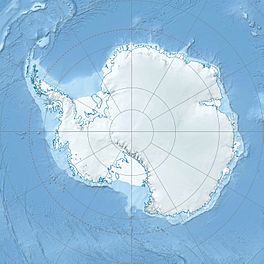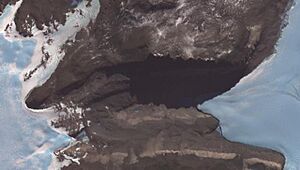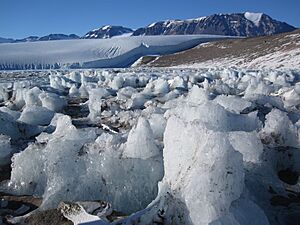Taylor Glacier facts for kids
Quick facts for kids Taylor Glacier |
|
|---|---|
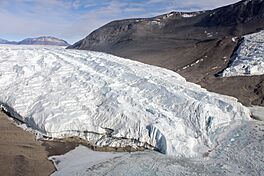 |
|
| Type | Polar Glacier |
| Location | Antarctica |
| Coordinates | 77°44′S 162°10′E / 77.733°S 162.167°E |
| Status | Stable |
The Taylor Glacier is a huge river of ice in Antarctica. It is about 35 nautical miles (65 kilometers) long. This amazing glacier flows from a high flat area called the Victoria Land plateau. It moves into the western part of the Taylor Valley. The glacier is located north of the Kukri Hills and south of the Asgard Range.
Contents
Discovering Taylor Glacier
The Taylor Glacier was first found by explorers from the British National Antarctic Expedition between 1901 and 1904. At first, they thought it was part of another glacier called the Ferrar Glacier.
Later, in 1910, a group from the Terra Nova Expedition explored the area more closely. They discovered that the upper and lower parts of what they thought was the Ferrar Glacier were actually two different glaciers joined together.
Because of this discovery, the famous explorer Robert Falcon Scott named the upper part of the ice river "Taylor Glacier." He named it after Thomas Griffith Taylor. Taylor was a geologist and led the exploration party that made this important discovery.
How Taylor Glacier Moves
Scientists from universities like University of California, Berkeley and the University of Texas at Austin have studied Taylor Glacier. They want to understand how it moves.
Most glaciers around the world are "wet-based." This means their bottoms slide over the ground. As they move, they scrape up rocks and dirt. This creates large piles of debris called moraines along their sides.
But Taylor Glacier is special. It is a "cold-based" glacier. This means its bottom is frozen solid to the ground underneath. Cold-based glaciers move differently. They flow slowly, almost like thick putty, pushed by their own heavy weight.
Because they are frozen to the ground, cold-based glaciers don't pick up much rock or dirt. They cause very little erosion. Their surfaces are also much flatter and smoother. They don't have as many deep cracks, called crevasses, as wet-based glaciers.
Where to Find Taylor Glacier
The Taylor Glacier starts high up on the polar plateau. This is west of Horseshoe Mountain. It flows eastward, passing several interesting places.
To its south are the Quartermain Mountains, with Finger Mountain. To its north is the Asgard Range, home to Beehive Mountain.
The glacier then turns southeast. It flows past unique spots like Solitary Rocks and Cavendish Icefalls. It also passes Knobhead to the south.
At one point, Taylor Glacier is very close to the Ferrar Glacier. They are almost like twin glaciers joined together! But then they separate. Taylor Glacier continues east, north of the Kukri Hills. Ferrar Glacier flows south of these hills.
Smaller glaciers, like Catspaw Glacier, flow towards Taylor Glacier but don't quite reach it. Finally, Taylor Glacier ends at the western edge of the Taylor Valley. A small part of it even flows into Lake Bonney.
Amazing Features of Taylor Glacier
The Taylor Glacier area has many interesting natural features.
Taylor Dome: An Ice Source
The Taylor Dome is a large, oval-shaped ice dome. It is about 43 nautical miles (80 kilometers) long. This dome rises to 2,400 meters (7,874 feet) high. It is one of the places where the Taylor Glacier gets its ice.
Depot Nunatak: A Historic Stop
Depot Nunatak is a tall rock peak, 1,980 meters (6,496 feet) high. It stands next to the glacier. Early explorers from the British National Antarctic Expedition named it. They used this spot in 1903 to store food and supplies for their journey.
Simmons Basin and Lake
Simmons Basin is a valley that is free of ice. It runs southeast near the glacier. The lower part of this valley holds Simmons Lake. This lake is about 1.5 nautical miles (2.8 kilometers) long. Both were named after George M. Simmons, Jr., a biologist who studied lakes in the area.
Lake Joyce: An Icy Wonder
Lake Joyce is a unique lake found along the northern side of Taylor Glacier. It is about 0.5 nautical miles (0.9 kilometers) long and 140 feet (43 meters) deep. What makes it special is that it's covered by 22 feet (7 meters) of very clear ice all year round! Scientists from New Zealand studied it in the 1960s.
Blood Falls: The Red Waterfall
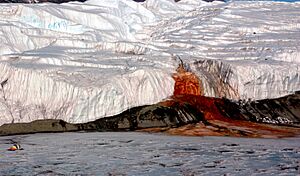
One of the most amazing sights is Blood Falls. This is a stream of salty water that flows out of the glacier. It looks red because it contains a lot of iron oxide, which is like rust. This red water flows onto the ice of Lake Bonney. The Australian geologist Thomas Griffith Taylor discovered this strange red flow in 1911.
Images for kids


